M
I
C
R
O
S
T
O
R
Y
O
F
A
R
T
........................................................

NOW COMPLETED:

........................................................
MICROSTORY OF ART
ONLINE JOURNAL FOR ART, CONNOISSEURSHIP
AND CULTURAL JOURNALISM
........................................................
INDEX | PINBOARD | MICROSTORIES |
FEATURES | SPECIAL EDITIONS |
HISTORY AND THEORY OF ATTRIBUTION |
ETHNOGRAPHY OF CONNOISSEURSHIP |
SEARCH

........................................................



 >MICROSTORIES
>MICROSTORIES
- Richard Serra
- Martin Scorsese
- Claude Simon
- Sunshine
- Werner Herzog
- The Creation
- Marcel Duchamp
- Nino Rota
- Wölfflin and Woolf
- Hansjörg Schneider
- Kraftort Arkadien
- Visual Biography
- Schlaraffenleben
- Die Geisteswissenschaften
- The Voyeur
- Buzzword Sustainability
- Paul Verlaine
- Tao Yuanming
- New Beginning
- Seneca
- Still Lifes
- Charles Baudelaire
- Frédéric Chopin
- The Art History of Sustainability
- Wang Wei
- Solarpunk
- Historians of Light
- Lepanto
- Renaturalization
- Plates
- Snow in Provence
- Learning to See
- Picasso Dictionaries
- Peach Blossom Spring
- Picasso Tourism
- Tipping Points
- Sviatoslav Richter
- Weather Reports
- Treasure Hunt
- Another Snowscape in Picasso
- Picasso in 2023
- Dragon Veins
- The Gloomy Day
- The Art of the Pentimento
- Reforestation
- The Status of Painting
- Emergency Supply
- Punctuality
- Watching Traffic
- Zhong Kui
- How Painting Survived the 1990s
- Confirmation Bias
- Sustainability and Luxury
- Garage Bands
- Picasso and Artificial Intelligence
- Eyes of Tomorrow
- Picasso in 2023 2
- Gluing Oneself to Something
- Suburbia
- Bamboo
- Sustainability and Carpe Diem 1
- Interviews with Bruegel
- Sustainability and Carpe Diem 2
- Coffee & Sugar
- Bamboo 2
- Picasso in 2023 3
- Sustainability and Carpe Diem 3
- Cherry Orchard
- Old Magazines
- Chance
- Nick Drake
- Harlequin
- The Smartphone & the Art Book
- Atlas Syndrome
- The Kitchen
- Atlas Syndrome 2
- Consideration
- Tori Amos
- School
- Orchard Auctioning Day
- The Hundred Years’ War
- Sócrates
- Chameleon
- Nefertiti Bust
- Picasso as a Computer
- Sunflowers
- Philemon & Baucis
- Ode to the Radio
- Childhood
- Wimmelbild
- Restitution
- Nick Drake 2
- Wishful Thinking
- Sundays
- The Independent Scholar
- September
- The Fisherman by Pirosmani
- Microadventure
- Sociology
- Salvator Mundi
- Chillon
- Appassionata
- Amber
- Homer
- Berlin
- Planet Walk
- Improvisation
- Seeing Picasso
- These Nice Kids
- Robber
- The One
- The Sea Turtle
- Zoo
- Through the Hush
- Wunderkammer
- I Do Not Seek, I Find
- Shopping Mall
- Food Hamper
- The Secretary
- This Gate
- Nor Rainy Day
- House on a Hill
- Beautiful Island
- Second-hand Bookstore
- Flat
- Slap in the Face
- Serra, Wenkenpark
- Apologies
- The Bells
- Nordmann Fir
- Picasso Wanting To Be Poor
- Picasso, Pirosmani
- A Brief History of Sculpture
- 24 Sunsets
- Rusty Phoenix
- Glove
- Wintry Stanza
- A Song
- Like A Beatle
- Catching An Orange
- Solar Bees
- Permaculture

 >FEATURES
>FEATURES
- Van Gogh On Connoisseurship
- Two Museum’s Men
- Ende Pintrix and the City in Flames
- Titian, Leonardo and the Blue Hour
- The Man with the Golden Helmet: a documentation
- Un Jury d’admission à l’expertise
- Learning to See in Hitler’s Munich
- Leonardo da Vinci and Switzerland
- The Blue Hour Continued
- The Blue Hour in Louis Malle
- Kafka in the Blue Hour
- Blue Matisse
- Blue Hours of Hamburg and LA
- A Brief History of the Cranberry
- The Other Liberale in the House
- The Blue Hour in Raphael
- Who Did Invent the Blue Hour?
- Monet on Sustainability
- Velázquez and Sustainability
- The Blue Hour in Guillaume Apollinaire
- Van Gogh on Sustainability
- The Blue Hour in Marcel Proust
- Picasso and Sustainability
- The Contemporary Blue Hour
- The Blue Hour in 1492
- The Blue Hour in Hopper and Rothko
- Hopper and Sustainability
- The Blue Hour in Ecotopia
- The Hour Blue in Joan Mitchell
- Explaining the Twilight
- The Twilight of Thaw
- The Blue Hour in Pierre Bonnard
- Explaining the Twilight 2
- Picasso on Stalin
- Rubens on Sustainability
- The Salvator Mundi in Bruegel and Rubens
- The Blue Hour in Leonardo da Vinci and Poussin
- The Blue Hour in Rimbaud
- Faking the Dawn
- Frost and Thaw in Ilya Ehrenburg
- Picasso, Stalin, Beria
- Picasso, Solzhenitsyn and the Gulag
- Shostakovich on Picasso
- Hélène Parmelin in 1956
- Historians of Picasso Blue
- Picasso Travelling to Moscow 1
- The Blue Hour in Caravaggio
- Picasso Travelling to Moscow 2
- Picasso, the Knife Game and the Unsettling in Art
- Some Notes on Leonardo da Vinci and Slavery
- Picasso Moving to the Swiss Goldcoast
- The Blue Hour in Camus
- The Blue Hour in Symbolism and Surrealism
- Caspar David Friedrich in His Element
- Exhibiting the Northern Light
- Caspar David Friedrich in His Element 2
- Robert Schumann and the History of the Nocturne
- The Blue Hour in Robert Schumann
- Caspar David Friedrich and Sustainability
- The Twilight of Thaw 2
- Multicultural Twilight
- The Blue Hour in Anton Chekhov
- The Blue Hour in Medieval Art
- Twilight Photography
- The Blue Hour in Bob Dylan
- Iconography of Optimism

 >SPECIAL EDITIONS
>SPECIAL EDITIONS
- Visions of Cosmopolis
- Mona Lisa Landscapes
- Turner and Ruskin at Rheinfelden
- Painters On TV & On TV
- Spazzacamini in Art
- A Last Glance at Le Jardin de Daubigny
- The Experimental Cicerone
- A Dictionary of Imaginary Art Historical Works
- Iconography of Blogging
- Begegnung auf dem Münsterplatz
- Cecom
- Das Projekt Visual Apprenticeship
- Those Who See More
- A Fox on Seeing with the Heart
- Sammlung Werner Weisbach
- Daubigny Revisited
- Some Salvator Mundi Microstories
- Some Salvator Mundi Afterthougths
- Some Salvator Mundi Variations
- Some Salvator Mundi Revisions
- A Salvator Mundi Questionnaire
- A Salvator Mundi Puzzle
- Unknown Melzi
- Francis I and the Crown of Charlemagne
- From Amboise to Fontainebleau
- Drones Above Chambord
- Looking Back At Conques
- Flaubert At Fontainebleau
- Images of Imperial Ideology
- The Chronicles of Santa Maria delle Grazie
- Seeing Right Through Someone
- Melzi the Secretary
- Eying Glass
- A Foil to the Mona Lisa
- A Renaissance of the Cartoon
- Sketching a Family Tree
- Venetian Variations
- A Brief History of Digital Restoring
- A Consortium of Painters
- Leonardeschi and Landscape
- A Christ in Profile
- Learning to See in Spanish Milan
- A History of Gestures
- Leonardo and Josquin
- A Renaissance of the Hybrid
- Suida and Heydenreich
- The Watershed
- Three Veils
- From Beginning to End
- Connoisseurship of AI
- Twilight and Enlightenment
- The Blue Hour in Chinese Painting
- Dusk and Dawn at La Californie
- Iconography of Sustainability
- The Blue Hour in Goethe and Stendhal
- The Sky in Verlaine
- The Blue Hour in Paul Klee
- Iconography of Sustainability 2
- The Blue Hour in Charles Baudelaire
- From Bruegel to Solarpunk
- Some Salvator Mundi Documentaries
- Some More Salvator Mundi Monkey Business
- The Windsor Sleeve
- Brigitte Bardot’s Encounter with Picasso
- Art Historians and Historians
- A Salvator Mundi Chronicle
- The Salvator Mundi and the French Revolution
- The Fontainebleau Group
- The Encounter of Harry Truman with Pablo Picasso
- The Fontainebleau Group Continued
- The Windsor Sleeve Continued
- The Salvator Mundi in Early Netherlandish Painting 1
- Some Salvator Mundi Resources
- A New Salvator Mundi Questionnaire
- The Woman in Picasso
- The Yarborough Group
- Melzi, Figino and the Mona Lisa
- The Yarborough Group Continued
- A Salvator Mundi Global History
- The Salvator Mundi in Medieval Art
- The Salvator Mundi in Medieval Art 2
- The Salvator Mundi in Early Netherlandish Painting 2


 >HISTORY AND THEORY OF ATTRIBUTION
>HISTORY AND THEORY OF ATTRIBUTION
- The Mysterious »Donna Laura Minghetti-Leonardo«
- Assorted Demons of Connoisseurship
- Panofsky Meets Morelli
- Discovering the Eye of Sherlock Holmes
- Handling the Left-handed Hatchings Argument
- Visual History of Connoisseurship
- Alexander Perrig
- Connoisseurship in 2666
- What Postmodernity Has Done to Connoisseurship
- Dividing Four Fab Hands
- A Leonardesque Ambassador
- Test Cases in Connoisseurship
- A Raphael Expertise
- How to Tell Titian from Giorgione
- Louise Richter
- The Unique Property in the History of Connoisseurship
- An Expertise by Berenson
- The Book of Expertises
- An Album of Expertises
- An Expertise by Friedländer
- A Salvator Mundi Provenance
- How to Tell Leonardo from Luini
- An Expertise by Crowe and Cavalcaselle
- An Expertise by Bayersdorfer
- An Expertise by Hermann Voss
- An Expertise by Hofstede de Groot
- Leonardeschi Gold Rush
- An Unknown »Vermeer«
- An Expertise by Roberto Longhi
- An Expertise by Federico Zeri
- A Salvator Mundi Geography
- A Salvator Mundi Atlas
- The Bias of Superficiality
- 32 Ways of Looking at a Puzzle
- James Cahill versus Zhang Daqian
- Five Fallacies in Attribution
- On Why Art History Cannot Be Outsourced to Art Dealers
- On Why Artificial Intelligence Has No Place in Connoisseurship
- Salvator Mundi Scholarship in 2016
- Leonardo da Vinci at the Courts
- The Story of the Lost Axe
- The Last Bruegel
- A Titian Questionnaire
- On Where and Why the Salvator Mundi Authentication Did Fail
- The Problem of Deattribution

 >ETHNOGRAPHY OF CONNOISSEURSHIP
>ETHNOGRAPHY OF CONNOISSEURSHIP
MICROSTORY OF ART
ONLINE JOURNAL FOR ART, CONNOISSEURSHIP
AND CULTURAL JOURNALISM
........................................................

***
ARCHIVE AND FURTHER PROJECTS

1) PRINT


***
2) E-PRODUCTIONS


........................................................

........................................................

........................................................
FORTHCOMING:


***
3) VARIA

........................................................

........................................................

........................................................

........................................................

........................................................
***
THE GIOVANNI MORELLI MONOGRAPH

- The Giovanni Morelli Monograph
........................................................
MICROSTORY OF ART
ONLINE JOURNAL FOR ART, CONNOISSEURSHIP AND CULTURAL JOURNALISM
HOME
MICROSTORY OF ART
ONLINE JOURNAL FOR ART, CONNOISSEURSHIP AND CULTURAL JOURNALISM
The Carl Adolph Mende Study
The Carl Adolph Mende Study  Attributed to Mende (sold at Auktionshaus Michael Zeller, Lindau am Bodensee, September 2006), Portrait of the Family Vonderbank of Aachen (Jean Gerard, his wife Catherina and their daughter Josephine; the book being Das gleichseitige Dreieck als Curvenzieher Geodolit by Jean Gerard Vonderbank, published in 1824; the painting, however, does not find mentioning in 19th century sources |
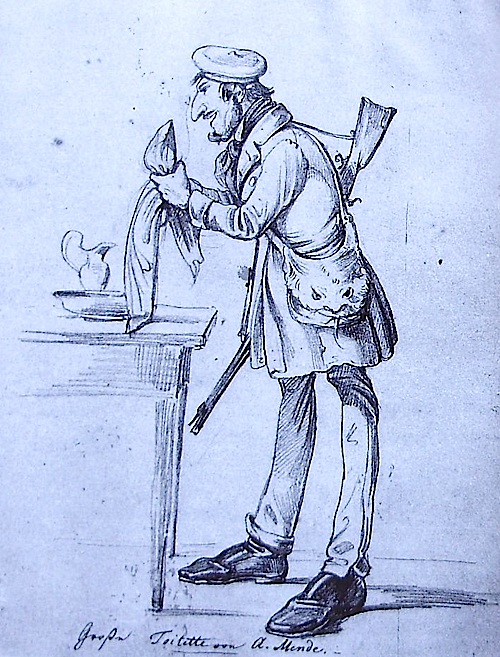
Ernst Fröhlich, Grosse Toilette von A. Mende
(source: Giovanni Morelli, Balvi magnus und
Das Miasma diabolicum, ed. by Jaynie Anderson,
Würzburg 1991, p. 80; the location of this pencil
drawing is the Antinori collection, Florence)

Andreas Achenbach, Profilköpfe
(with Mende on the right)
(source: artothek.com/Kupferstichkabinett
im Städel, Frankfurt a.M.)
This page will be dedicated to the life and times of German-born painter Carl Adolph Mende (1807-1857; spelling sometimes ›Karl‹; sometimes ›Adolf‹). I am interested in Mende for a number of reasons: besides my general interest in 19th century painting, and besides the challenge to put together, if not a catalogue raisonné, at least an informative page that also will be serving as a collecting point for informations relating to rather little known Mende, this page will also work as another supplement to my Morelli portrait. Because Mende, who got to know young Giovanni Morelli at Munich, did not only embark with Morelli on a grand tour throughout Italy, he is also to be considered as being an eye witness of the ›Five Days of Milan‹ uprising in 1848, in which Morelli (probably with Mende) did take part and fought. Moreover Mende stayed, if only for some time and later, at Basel, and all in all he is to be considered as a yet infortunate but nonetheless transnationally active and also artistically interesting painter of the 19th century. In brief: to study Mende does not mean exclusively to study Mende, but to study 19th century painting in general, not to forget 19th century political and cultural history. I am going to integrate visual materials into this virtual study, but for the moment every Mende attribution has to be taken with great caution. We will start from scratch (for basic biographical informations see here: http://www.deutsche-biographie.de/sfz61534.html).
This page is to be seen as a work in progress; if you got informations as to Carl Adolph Mende please do not hesitate to contact me (Dietrich Seybold) under the following e-mail address:
D.Seybold@bluewin.ch
1807: Mende born at Lipsia as the son of a merchant; as probably destined to the study of the law Mende turned to painting; according to Fr. Pecht (ADB) he stayed at Dresden before turning to Munich
1809: Tyrolian Rebellion, which is going to be the preferred subject of Mende, if painting history
1813: 5-year-old Mende possibly witnesses the Völkerschlacht bei Leipzig
1821: Mende (according to Nagler) attends the Akademie der Künste at Munich (others have the more likely date of 1828)
1822: a genre picture by Mende is shown (other sources say – see Christiane Kerrutt, Atelierbilder, that it was shown on the Akademieausstellung of 1829, as No. 319), depicting a young artist drawing a peasant; Nagler mentions also an early picture showing a young mother with her baby, and several pictures of a Zillerthalerbub, betend vor seinem Mues und mit der Schalmei
1828 (or c. 1828): Grand Duchess Anna Feodorovna wearing white dress, red shawl (sold at Sotheby’s, December 14, 1995; as to the sitter see: http://de.wikipedia.org/wiki/Juliane_von_Sachsen-Coburg-Saalfeld)
1830: Mutter und Kind am Tisch (sold at Kunsthaus Lempertz, Cologne, November 17, 2007)
1833: Flöte spielender Bub am Berggipfel (sold at auction in 2006, apparently in Austria); Mönch zeigt bayerischen Landleuten seine Reliquien (according to Thieme-Becker kept by the Städtisches Museum Riga)

Der Maler Heinrich Heinlein
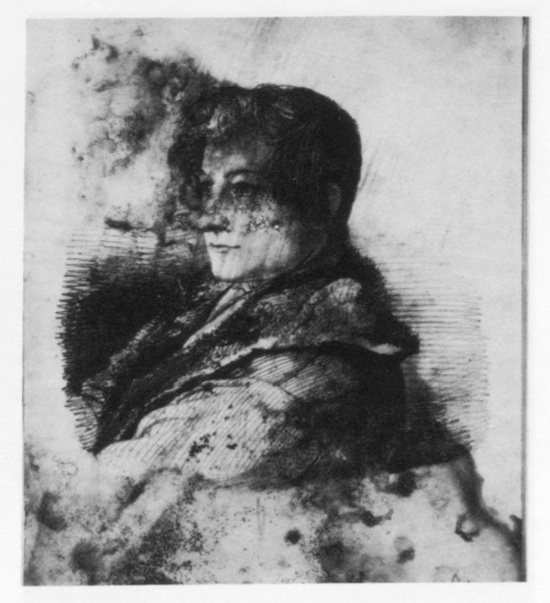
19-year-old Giovanni Morelli in 1835,
as seen and drawn by Mende
(source: Giovanni Morelli da collezionista a conoscitore,
[exh. cat.] Bergamo 1987, p. 77)
1834: Schusterwerkstatt (sold at auction in 2000, apparently in Germany); Meister mit Zwicker liest die Zeitung und beobachtet die Gesellen (sold at auction in 1999, apparently in Germany); Der Maler Heinrich Heinlein vor der Staffelei sitzend (sold at auction in 1999, apparently in Germany); Nagler mentions a ›Nachtstück‹, depicting a cleric coming back from the house of a dying man, shown in the Munich Kunstverein, as well as a politicising Schuster mit seinen Gesellen (compare the mentioned titles above), with the Schuster showing, according to Nagler an ›overwise physiognomy‹ and drawing all his wisdom from the Bayerischer Landbote in his hand; another ›Nachtstück‹ is mentioned by Nagler, showing a praying child, as well as the »Schlacht von Leipzig, welche Bauern von einem Dache aus beobachten« (according to Fr. Pecht Mende himself had thus witnessed the battle); Pecht mentions also Vertheidigung eines Engpasses von der Höhe herab durch Hofer, Speckbacher und Haspinger
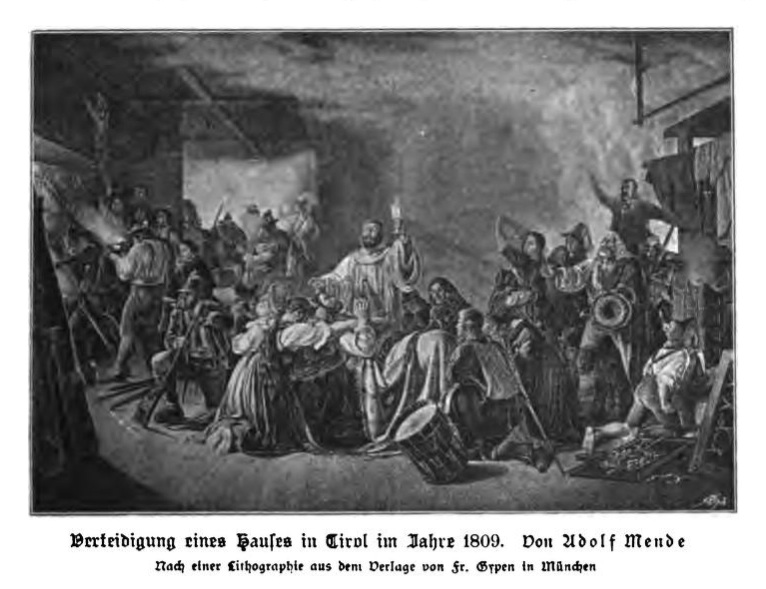
(Source: Pecht 1888, see text, p. 151)
1835: in Munich Mende portraits 19-year-old Giovanni Morelli (the dated and signed ink drawing is kept by the Accademia Carrara, Bergamo); Count Raczynski mentions, in his 1836-41 Histoire de l’art moderne en Allemagne, that the Kunstverein bought, in 1835, a painting showing une jeune fille assise devant une maison et lisant dans un vieux livre in-folio; Raczynski sees also another painting in the Kunstverein, showing possibly des Bedouins; (painter Christian Christoph) Ruben is further named as being the owner of un jeune pátre assis prés du feu sur un tertre; Dirndl mit Andachtsbuch vor der Hütte (sold at auction in 2001, apparently in Germany); a letter by Mende as of the year of 1835 and sent to an unknown recipient is kept by the Bayerische Staatsbibliothek of München
1836: according to Friedrich Pecht (Geschichte der Münchener Kunst im neunzehnten Jahrhundert, p. 149) Mende painted the ›Verteidigung eines Hauses‹ (see on the left the reproduction after the later lithography) in 1836

The island named Frauenchiemsee (picture: 20percent)
1837: Count Raczynski sees un enfant couché enfoncé dans ses coussins, et qui s’endort en tenant entre ses mains un petit tambour; Mende, according to the 1867 article by Erwin Förster on Die Insel-Republik deutscher Künstler (published in: Die Gartenlaube, has joined the Malerkolonie auf Frauenchiemsee: »Weiter berichtet die Chronik von ihm, daß er Anno 37 sich drei Viertel Jahre auf Frauenchiemsee aufhielt, ›also daß unter den Eingebornen eine arg Hungersnoth entstand, sintemalen vorbemeldeter Mende ihren ganzen Vorrath aufgezehrt hatte‹.
1838: Studienkopf aus Rom (possibly collection of Carl Schiller (1807-1874)); The Joy of Motherhood (sold at Dorotheum, Vienna, June 9, 2011); Mädchen mit besticktem Schal (sold at auction in 2004, apparently in Germany); a ›Szene aus dem Tirolerkriege‹ or a version of the Verteidigung eines Hauses (see 1849) is shown at the Kunstverein of Regensburg (see Kunstblatt 1839, No. 17, p. 66f., also for a lengthy description); Mende is said to have painted the picture ›am Chiemsee‹, and it apparently did take him two years; in 1838 or 1839, and perhaps at Frankfurt, Mende is portrayed by Andreas Achenbach (see small picture on the left to the header, which is kept by the Kupferstichkabinett of the Städel of Frankfurt a.M.)

Mutterglück (›Joy of Motherhood‹)
1839: Young Woman Praying (sold at Allgäuer Auktionshaus, Kempten, April 19 2001); Vor Bildstock knieendes Dirndl im Hochgebirge (sold at auction in 2001, apparently in Germany); December: Mende, who is also in touch with Giovanni Morelli’s Munich-based friend Bonaventura Genelli, has read Morelli’s youthful satirical play Kunstkenner (which up to the present day remains unpublished, although it might be extant)
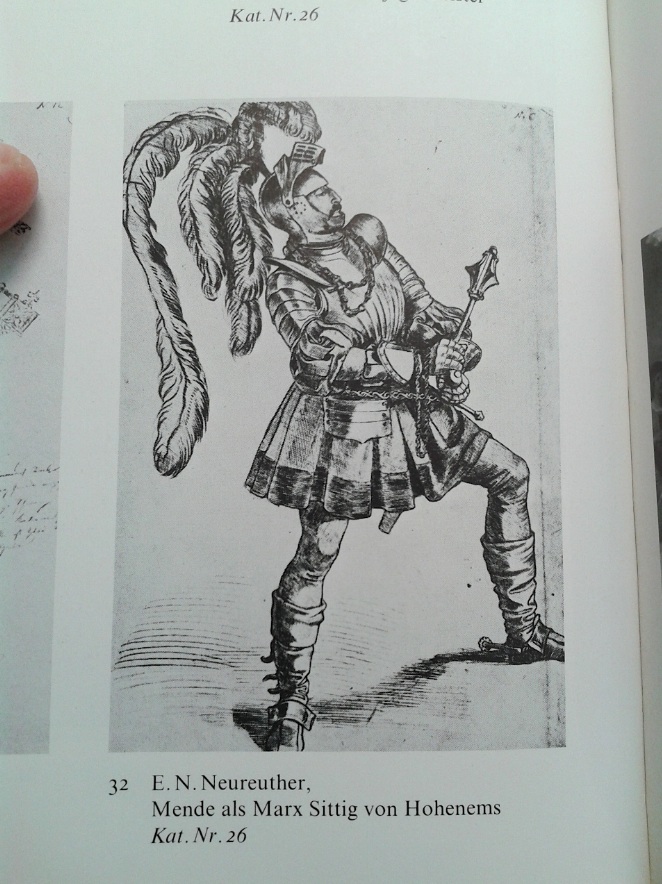
1840: Andreas Hofer mit Knaben auf verschneitem Gipfel (sold at auction in 2006, apparently in Germany); according to Pecht Mende turned to Leipzig to (unsuccesfully) paint portraits (he also mentions an Amor, der die Nachtigallen füttert); Eugen Napoleon Neureuther renders Mende »als Marx Sittig von Hohenems« (see Wolfgang Hartmann, Der historische Festzug, No. 32, and picture on the right); according to Bonaventura Genelli (letter to Giovanni Morelli as of August 1) Mende is settled in a cloister nearby Grafrath and Wildenroth, goes much hunting and is making studies after clerics and peasants
1842: Johann Michael von Söltl writes (in his Die bildende Kunst in München) on Mende: https://archive.org/stream/bub_gb_FaAZAAAAYAAJ#page/n205/mode/2up
1843: Mende travels with Giovanni Morelli to Genoa (March), Naples (April) and Palermo; in August they return to Bergamo; Mende, on occasion of this trip, had twice the occasion to draw the nobleman Gino Capponi, one of Morelli’s fatherly mentors
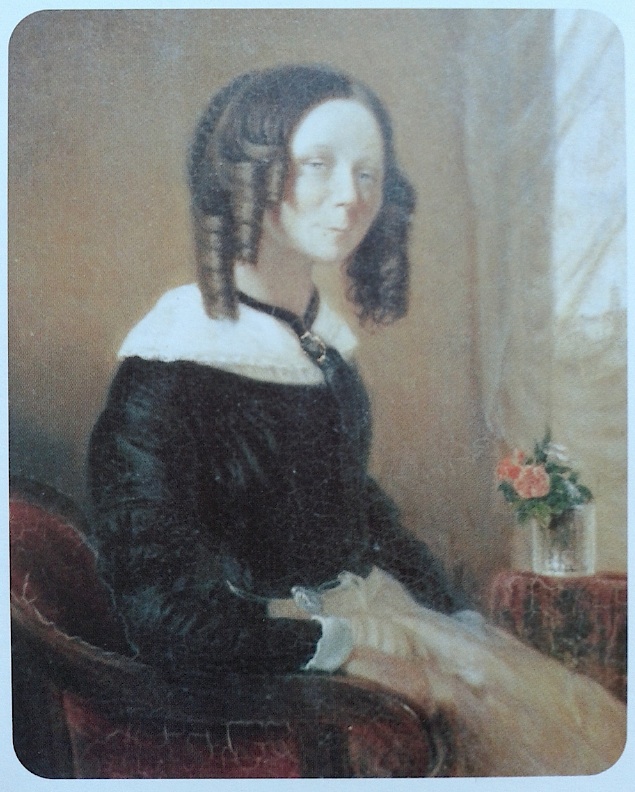
Unknown painter, Orsola Zavaritt (1795-1867)
(source: Silvio Honegger, Gli Svizzeri di Bergamo,
Bergamo 1997, p. 61)
1844: Mende, who has also finished a portrait of Giovanni Morelli’s 49-year-old mother Orsola (née Zavaritt), stays with Morelli; a ›Scene aus den Tyrolerkriegen‹ by Mende is shown at the Vienna Kunstausstellung (see: Kunstblatt 1844, p. 255)
1845 (c.): according to worldcat.org Bettina von Arnim sends a letter to Mende (who most likely has been recommended to her by Giovanni Morelli who had met and stayed with Bettina in 1838): »In a detailed letter to Karl Adolph Mende, von Arnim comments favorably on his recent lithographs and gives a pessimistic report of the arts in Berlin and the taste of Friedrich Wilhelm IV, focusing particularly on the interior decoration of the re-opened opera house (rebuilt in 1843 after its destruction by fire in 1842). In addition to her criticism of the opera house’s Rococo eclecticism, she regrets the lost opportunity to create a decorative scheme in a more classical style. She frequently cites the work of the painter Cornelius whom she dislikes, describing his work as barren and ashengrey.«
1847: 40-year-old Mende stays with Morelli at Lago di Pusiano (where Mende, according to Morelli, also is hunting ducks)

Lago Pusiano (picture: orobie.it)
1848: Milan Uprisings (Five Days of Milan) and First Italian War of Indepencence; Morelli, who is sent to Frankfurt by the provisional Milan government to ›explain‹ the Lombardian ›revolution‹ to the elected members of the German national assembly of the Paulskirche, travels with Mende to the lake of Constance where they split, with Morelli turning to Frankfurt and Mende probably to Lipsia; Mende apparently supports Adolf Heinrich Lier in his decision to turn to painting
1849: Verteidigung eines Hauses in Schwaz im Tirol 1809 (sold in 2006, apparently in Switzerland; compare also the notes to 1836 and 1838); Nagler says (probably as to this picture, or/and as to the one mentioned in 1838/39): »Die Handlung geht im Innern des Hauses vor; Männer schiessen durch das Fenster auf die Feinde, Weiber und Kinder sind in Angst und Erwartung, und den Mittelpunkt nimmt der Priester mit dem Sacramente ein, welches ein Sterbender empfängt. J. Wölfle hat dieses schön componirte Bild lithographiert, und der Maler dedicirte das grosse Blatt dem Könige von Sachsen.«; according to Pecht, who also describes the picture at length, Mende did gain some reputation with this picture, based on the stylistic principles of the Cornelius school; Pecht mentions also humoristic pictures by Mende (besides the politicising Schuster also a Vorbereithung auf das Kirchweihfest in einem Kloster
1851: Mende stays at Basel where, as Morelli gets to know, he does not feel comfortable; a Baseler Stillleben depicts a gambling party in a Basel hotel at Freie Strasse
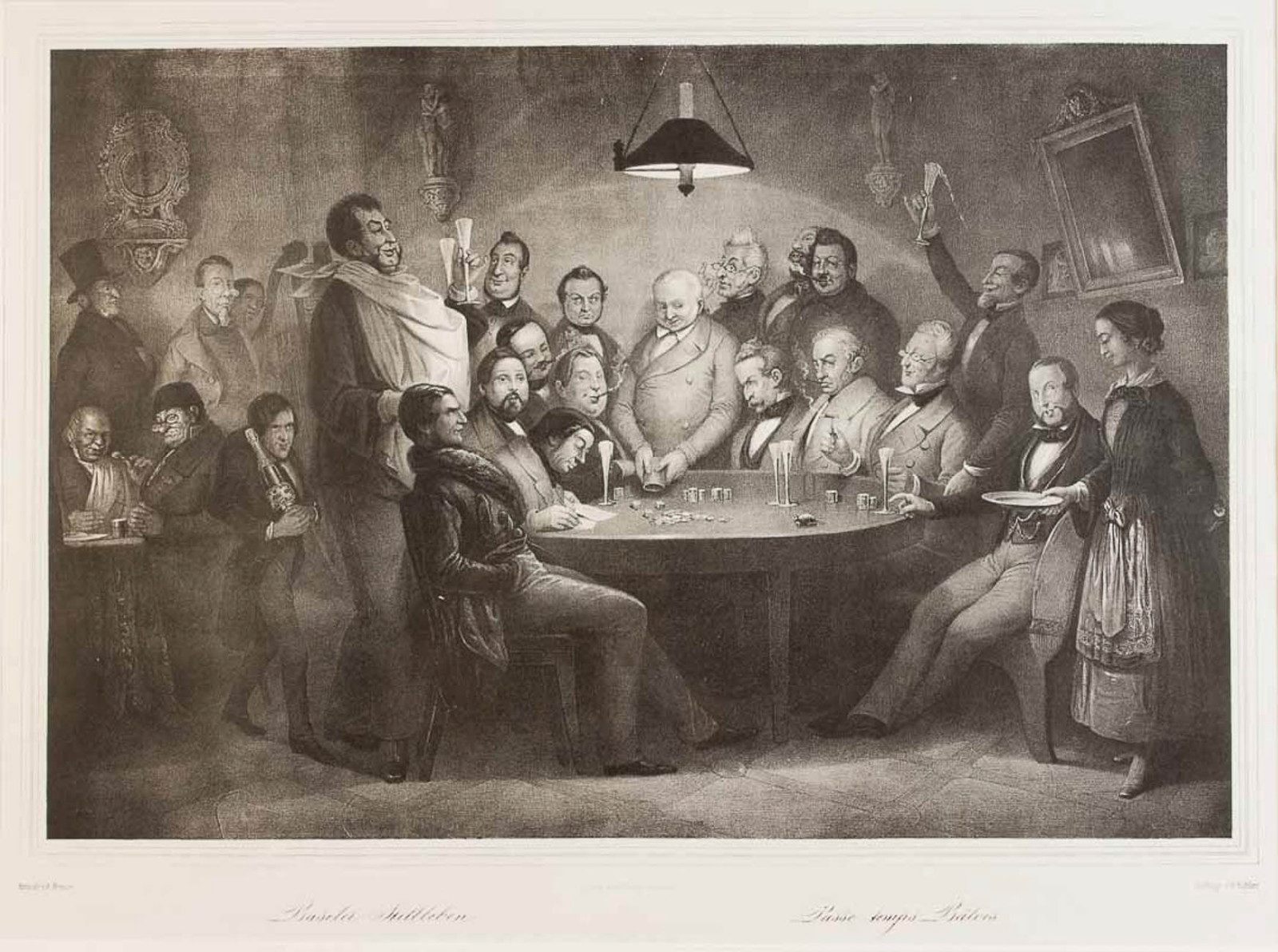
Lithograph after the Baseler Stillleben by Carl Adolph Mende (picture: auktionen-vogler.ch); the subject given here
in this work after Mende can possibly be described as: ›Spielergesellschaft im Hotel Wilder Mann‹ (›a gambling party
at the Hotel Wilder Mann‹); the Basel hotel that here is referred to was situated at the Freie Strasse,
close to the main post office in Rüdengasse
See also: http://query.staatsarchiv.bs.ch/query/detail.aspx?ID=565611
1852: Bewaffnete Schmuggler im Hochgebirge (sold at auction in 2000, apparently in Germany)
1854: Mende is seemingly recommended (by a letter, dated Januar 17 and sent from Osterode) to archivist and collector Georg Kestner (1774-1867)
1857: Mende drowns in the river Weser at Achim
***
1876: Josef Maillinger, in his Bilder-Chronik, vol. 2, p. 120, assembles some works by and after Mende (see: http://digital.staatsbibliothek-berlin.de/werkansicht/?PPN=PPN74935691X&PHYSID=PHYS_0132 and http://digital.staatsbibliothek-berlin.de/werkansicht/?PPN=PPN74935691X&PHYSID=PHYS_0266)
1898: Friedrich von Boetticher, Malerwerke II/1, with a list of works by Mende on p. 13: https://archive.org/stream/malerwerkedesne01boetgoog#page/n22/mode/2up
See also my The Giovanni Morelli Monograph
MICROSTORY OF ART
ONLINE JOURNAL FOR ART, CONNOISSEURSHIP AND CULTURAL JOURNALISM
HOME
© DS